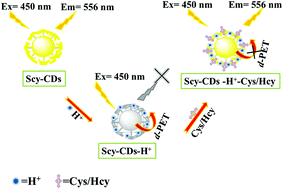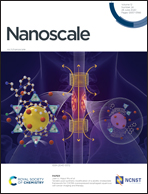Carbon dots for lysosome targeting and imaging of lysosomal pH and Cys/Hcy in living cells†
Abstract
The abnormal concentrations of both biothiols and pH in lysosomes are seriously related to many major diseases, such as Parkinson's and Alzheimer's diseases. Up to now, there are few reports that clearly illustrate the relationship between lysosomal pH and biothiols via fluorescence assay. Herein, novel carbon dots (Scy-CDs) are prepared with good water dispersibility and excellent photostability, and a large Stokes shift of 106 nm is exhibited under an excitation wavelength of 450 nm. The remarkable pH-dependent behavior of Scy-CDs is presented with the fluorescence quenching based on the donor-excited photoinduced electron transfer (d-PET) process. The pKa value is 5.30, which is in good agreement with the range of the normal and abnormal lysosomal pH. Upon the addition of cysteine (Cys) or homocysteine (Hcy), the d-PET process is effectively inhibited with fluorescence recovery totally. The significant co-localization of Scy-CDs with Lyso-Tracker Deep Red in HEp-2 cells and the Pearson correlation coefficient 0.88 strongly suggest that the Scy-CDs can target lysosomal pH and Cys/Hcy in living cells.



 Please wait while we load your content...
Please wait while we load your content...